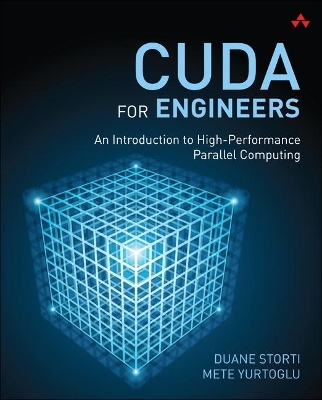
CUDA for Engineers
Addison Wesley (Verlag)
978-0-13-417741-0 (ISBN)
The authors introduce the essentials of CUDA C programming clearly and concisely, quickly guiding you from running sample programs to building your own code. Throughout, you’ll learn from complete examples you can build, run, and modify, complemented by additional projects that deepen your understanding. All projects are fully developed, with detailed building instructions for all major platforms.
Ideal for any scientist, engineer, or student with at least introductory programming experience, this guide assumes no specialized background in GPU-based or parallel computing. In an appendix, the authors also present a refresher on C programming for those who need it.
Coverage includes
Preparing your computer to run CUDA programs
Understanding CUDA’s parallelism model and C extensions
Transferring data between CPU and GPU
Managing timing, profiling, error handling, and debugging
Creating 2D grids
Interoperating with OpenGL to provide real-time user interactivity
Performing basic simulations with differential equations
Using stencils to manage related computations across threads
Exploiting CUDA’s shared memory capability to enhance performance
Interacting with 3D data: slicing, volume rendering, and ray casting
Using CUDA libraries
Finding more CUDA resources and code
Realistic example applications include
Visualizing functions in 2D and 3D
Solving differential equations while changing initial or boundary conditions
Viewing/processing images or image stacks
Computing inner products and centroids
Solving systems of linear algebraic equations
Monte-Carlo computations
Duane Storti is a professor of mechanical engineering at the University of Washington in Seattle. He has thirty-five years of experience in teaching and research in the areas of engineering mathematics, dynamics and vibrations, computer-aided design, 3D printing, and applied GPU computing. Mete Yurtoglu is currently pursuing an M.S. in applied mathematics and a Ph.D. in mechanical engineering at the University of Washington in Seattle. His research interests include GPU-based methods for computer vision and machine learning.
Acknowledgments xvii
About the Authors xix
Introduction 1
What Is CUDA? 1
What Does “Need-to-Know” Mean for Learning CUDA? 2
What Is Meant by “for Engineers”? 3
What Do You Need to Get Started with CUDA? 4
How Is This Book Structured? 4
Conventions Used in This Book 8
Code Used in This Book 8
User’s Guide 9
Historical Context 10
References 12
Chapter 1: First Steps 13
Running CUDA Samples 13
Running Our Own Serial Apps 19
Summary 22
Suggested Projects 23
Chapter 2: CUDA Essentials 25
CUDA’s Model for Parallelism 25
Need-to-Know CUDA API and C Language Extensions 28
Summary 31
Suggested Projects 31
References 31
Chapter 3: From Loops to Grids 33
Parallelizing dist_v1 33
Parallelizing dist_v2 38
Standard Workflow 42
Simplified Workflow 43
Summary 47
Suggested Projects 48
References 48
Chapter 4: 2D Grids and Interactive Graphics 49
Launching 2D Computational Grids 50
Live Display via Graphics Interop 56
Application: Stability 66
Summary 76
Suggested Projects 76
References 77
Chapter 5: Stencils and Shared Memory 79
Thread Interdependence 80
Computing Derivatives on a 1D Grid 81
Summary 117
Suggested Projects 118
References 119
Chapter 6: Reduction and Atomic Functions 121
Threads Interacting Globally 121
Implementing parallel_dot 123
Computing Integral Properties: centroid_2d 130
Summary 138
Suggested Projects 138
References 138
Chapter 7: Interacting with 3D Data 141
Launching 3D Computational Grids: dist_3d 144
Viewing and Interacting with 3D Data: vis_3d 146
Summary 171
Suggested Projects 171
References 171
Chapter 8: Using CUDA Libraries 173
Custom versus Off-the-Shelf 173
Thrust 175
cuRAND 190
NPP 193
Linear Algebra Using cuSOLVER and cuBLAS . 201
cuDNN 207
ArrayFire 207
Summary 207
Suggested 208
References 209
Chapter 9: Exploring the CUDA Ecosystem 211
The Go-To List of Primary Sources 211
Further Sources 217
Summary 218
Suggested Projects 219
Appendix A: Hardware Setup 221
Checking for an NVIDIA GPU: Windows 221
Checking for an NVIDIA GPU: OS X 222
Checking for an NVIDIA GPU: Linux 223
Determining Compute Capability 223
Upgrading Compute Capability 225
Appendix B: Software Setup 229
Windows Setup 229
OS X Setup 238
Linux Setup 240
Appendix C: Need-to-Know C Programming 245
Characterization of C 245
C Language Basics 246
Data Types, Declarations, and Assignments 248
Defining Functions 250
Building Apps: Create, Compile, Run, Debug 251
Arrays, Memory Allocation, and Pointers 262
Control Statements: for, if 263
Sample C Programs 267
References 277
Appendix D: CUDA Practicalities: Timing, Profiling, Error Handling, and Debugging 279
Execution Timing and Profiling 279
Error Handling 292
Debugging in Windows 298
Debugging in Linux 305
CUDA-MEMCHECK 308
Using Visual Studio Property Pages 309
References 312
Index 313
| Erscheint lt. Verlag | 24.12.2015 |
|---|---|
| Verlagsort | Boston |
| Sprache | englisch |
| Maße | 187 x 234 mm |
| Gewicht | 596 g |
| Themenwelt | Mathematik / Informatik ► Informatik ► Grafik / Design |
| Mathematik / Informatik ► Informatik ► Programmiersprachen / -werkzeuge | |
| Mathematik / Informatik ► Informatik ► Software Entwicklung | |
| Mathematik / Informatik ► Informatik ► Theorie / Studium | |
| ISBN-10 | 0-13-417741-X / 013417741X |
| ISBN-13 | 978-0-13-417741-0 / 9780134177410 |
| Zustand | Neuware |
| Haben Sie eine Frage zum Produkt? |
aus dem Bereich


